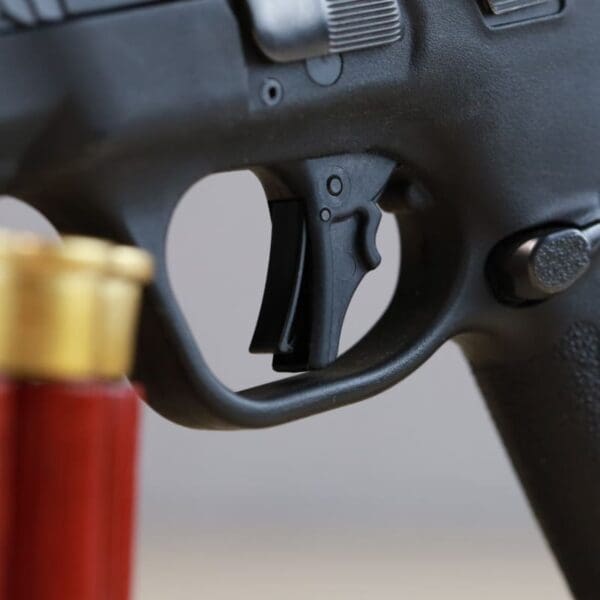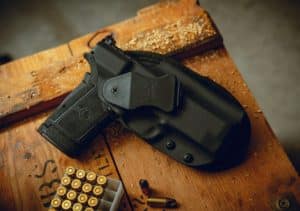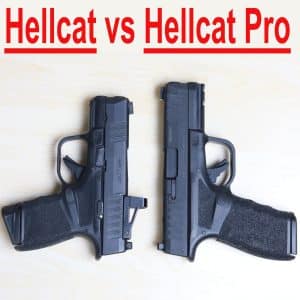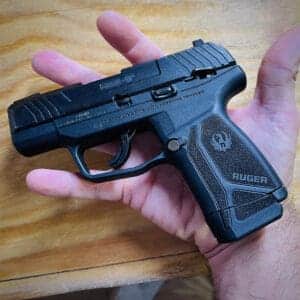
Smith & Wesson Equalizer vs Shield Plus
S&W Equalizer vs Shield Plus: Is the Equalizer Better for Concealed Carry?
Updated: 10/22/2024

Yes, the S&W Equalizer is better for concealed carry. The S&W Shield Plus is good. However, the Equalizer is better.
The S&W Shield Plus remains a standout pistol for its compact size and lightweight design. However, the Equalizer matches it in both aspects and even steps up the competition. Both pistols offer a magazine capacity ranging from 10 to 13 rounds, ensuring they’re on equal footing in firepower.
Its user-friendly features that enhance handling and safety set the Equalizer apart. It boasts a passive grip safety, making it exceptionally secure and easy to handle, especially for new shooters. Additionally, the slide of the Equalizer is notably easier to rack, and the take-down lever is much more user-friendly, simplifying maintenance and accessibility. The Equalizer matches the Shield Plus in capability and adds these significant improvements, making it an attractive option for those seeking a reliable and easy-to-use firearm.


While the S&W Shield Plus remains a standout choice, the S&W Equalizer has taken the spotlight as an exceptional firearm for concealed carry. There’s much more beneath the surface of this claim, however. Join us as we dive into a comprehensive explanation to see why the Equalizer has quickly become one of the top contenders in the market.
Smith & Wesson Equalizer vs Shield Plus
Overall specs

Build Quality


That’s great engineering and great build quality.
Magazines

The magazines for both pistols are identical and interchangeable, enhancing their versatility. Additionally, the magazine well on the Equalizer features a slight chamfer on the front strap side, designed to facilitate smoother and quicker magazine changes by minimizing potential snags during reloads.
Smith & Wesson continues to offer a flush-fitting 10-round magazine with both models, along with an extended 13-round magazine for increased capacity. Uniquely, the Equalizer now includes a 15-round magazine as a standard option in the box, providing even greater capacity right out of the gate. While this 15-round magazine is also compatible with the Shield Plus, it remains an accessory that must be purchased separately should Shield Plus owners wish to enhance their carrying capacity.
Ease Of Concealment (Good for Concealed Carry?)

Smaller pistols continue to be a preferred choice for better concealment due to their compact size. Both pistols in question maintain similar dimensions, thus offering comparable concealability.
However, for those who opt for appendix carry, the shorter barrel of the Shield Plus might be more appealing. This is because a longer barrel can uncomfortably press against the crotch area when seated, a common concern with appendix carry.
On the other hand, the majority of our holster customers, more than 90%, choose to carry their pistols just behind the hip in the strong side position. Here, the length of the barrel has minimal impact on concealment effectiveness.
Comparing specifics, the Shield Plus with a 3-inch barrel measures 6.1 inches in total length, while the Equalizer stands slightly longer at 6.75 inches. For those preferring a longer barrel, the Shield Plus is also available with a 4-inch barrel, extending its length to 7.0 inches.
This positions the Equalizer as a mid-point option—it’s roughly two-thirds of an inch longer than the shorter Shield Plus but slightly shorter than the Shield Plus with the extended barrel. This variety allows users to select a size that best meets their comfort and concealment needs.

In the realm of concealed carry, the weight of your firearm is a critical consideration. You certainly don’t want a gun that’s so heavy it pulls your pants down—a fashion faux pas that hasn’t been in style for years.
Take, for instance, the Shield Plus, which weighs in at either 19.3 ounces or 23.8 ounces, depending on the model you choose. The variant with the 4-inch barrel is understandably heavier. Then there’s the Equalizer, which strikes a balance at 22.9 ounces. While the difference of 3 ounces might seem negligible, in the world of concealed carry, every ounce counts, though it’s unlikely you’d notice such a slight weight differential when the pistol is snug in a quality concealed carry holster. Consider this: a single 9mm cartridge weighs almost half an ounce. Would you feel the weight difference if you discharged half your magazine? Possibly, but it would require quite a bit of contemplation.
Ultimately, both pistols conceal well, offering little difference in the practical experience of carrying. Yet, for many, the peace of mind provided by the Equalizer’s grip safety is a decisive factor. This feature alone can make it significantly more reassuring to carry a loaded firearm, particularly in sensitive carry positions like appendix carry. For those individuals, the Equalizer not only offers a manageable weight but also an added layer of safety that makes concealed carry feel more secure and intuitive.
——— Holster Selection


Be careful to find a holster that is safe, functional, and comfortable. It must conceal well and be comfortable enough to wear all day long.
Thank goodness there’s Clinger Holsters.
The Clinger Comfort turns any of our Kydex holsters into the most comfortable holster you’ve ever used.
Clinger Holsters conceal so well, nobody will know you are concealing.
With an incredible warranty and Two-Week Buy Back Guarantee, everybody should try Clinger Holsters.
Shooting Impressions
Recoil
The recoil of both the Shield Plus and the Equalizer remains impressively manageable for their compact sizes. These pistols are noted for their gentle recoil, which facilitates swift, accurate follow-up shots. While full-size Smith & Wesson models naturally exhibit less recoil due to their larger frames and heavier weights, the Shield Plus and Equalizer stand out in the micro-compact category for their reduced kick compared to many peers.
In this category, it’s a draw. When comparing the Smith and Wesson Equalizer vs. Shield Plus, not every aspect can produce a definitive winner. Both models hold their ground well, making them excellent choices for those seeking reliable, light-recoiling firearms in the highly competitive micro-compact market.
Sights
The Equalizer is equipped with the classic 3-Dot sight system, a feature it shares with the Shield Plus. This system utilizes a single white dot on the front sight and two white dots on the rear sight. To aim, simply align the front dot evenly between the two rear dots. This configuration is designed for quick target acquisition, prioritizing rapid engagement over pinpoint precision.
For those seeking an upgrade, the Shield Plus is available in a Performance Center model, which includes enhanced fiber optic/tritium night sights. These premium sights offer exceptional visibility in low-light conditions, making them a superb choice for both everyday carry and tactical situations.

Trigger
Both of these pistols continue to stand out for their distinctive trigger systems, yet each remains exceptional in its performance.
The Shield Plus maintains its reputation with a classic striker-fired system, known for its reliability and straightforward mechanics. On the other hand, the Equalizer features a less conventional internal hammer-fired trigger, which offers a unique alternative to the typical striker-fired setup.
Despite their technical differences, both pistols deliver remarkably similar experiences when it comes to trigger performance: each trigger pull is crisp and clean, with minimal take-up, a satisfying break, and a quick reset. It’s intriguing how two fundamentally different systems can provide such comparable and excellent shooting experiences.

The S&W Equalizer Trigger is curved without an integrated trigger safety.
The S&W Shield Plus has a flatter trigger with a wide, integrated trigger safety. The Shield Plus has a bit of a more tactile and audible reset.
The Equalizer has a bit of a shorter reset. They are both excellent.
Ergonomics
The ergonomics of both these pistols are designed with comfort in mind, each featuring a frame that is rounded and fits naturally in the hand. However, in the realm of user-friendly features, the Equalizer by Smith & Wesson takes the lead over the Shield Plus.
Smith & Wesson has refined the ergonomics in the Equalizer, paying close attention to details that enhance user experience. For instance, while the Shield Plus opts for a very low-profile safety lever to maintain a slimmer silhouette for better concealment, the Equalizer offers a larger, more accessible thumb safety (on models equipped with this feature). This design choice significantly eases the process of engaging and disengaging the safety, particularly under stress.
Additionally, the Equalizer simplifies the operation with a lighter recoil spring that facilitates easier press-checks and a take-down lever that requires minimal effort to operate. The slide serrations on the Equalizer are also notably more pronounced than those on the Shield Plus, offering superior grip and handling ease. These deeper serrations provide a more secure hold, making slide manipulation smoother and more reliable.

Combining the deep serrations, cocking wings (on the back of the slide), and light recoil springs, you feel the difference. The Equalizer is easier on your hands, easier to use, and more ergonomic.

The S&W Equalizer stippling is very similar to the Shield Plus stippling.

Reliability
Safety
In the realm of firearm safety, the Equalizer stands out, particularly due to its integrated grip safety feature—a significant advantage for both new and experienced shooters alike. The beauty of passive safety mechanisms like this lies in their simplicity; the safety is automatically disengaged by the natural action of gripping and firing the pistol. This design minimizes the risk of accidental discharge, especially during the critical moments of holstering the firearm, ensuring nothing inadvertently engages the trigger.
Care must be taken not to depress the grip safety while holstering the gun. As long as the grip safety remains unengaged, the pistol remains securely non-firing. This feature was a game changer for me personally when I began my concealed carry journey with a Springfield XD—its presence provided an extra layer of reassurance when carrying a loaded weapon. Years down the line, grip safety continues to offer peace of mind without compromising the comfort or effectiveness of my grip, proving its enduring value in the design of safety-conscious firearms.
Both of these pistols are quite accurate for their size. These aren’t target pistols. However, both pistols are more than capable of firing accurately at combat distances.
——— Shameless Holster Plug
Take a moment and envision a day where your pistol is an integral part of your attire from morning until night. This isn’t about stowing it away in your vehicle’s glove compartment, but securely attaching it to your belt as you step out the door for the day.
Conclusion: S&W Equalizer VS S&W Shield Plus
Overall, both pistols hold their own, but the Equalizer increasingly stands out against the Shield Plus.
Dimensionally similar, with matching size, weight, and capacity, the distinction comes in the thoughtful design enhancements S&W has integrated into the Equalizer. Mirroring successful strategies from tech giants like Apple, S&W understands that ease of use translates to a more satisfying user experience.
The Equalizer’s passive grip safety and effortless slide-racking make it exceptionally user-friendly, enhancing its appeal for daily carry. It’s a superior choice for your concealed carry arsenal.
When you choose your Equalizer, be sure to complete your setup with a perfectly matched Clinger Holster. Be sure to grab your holster today.







